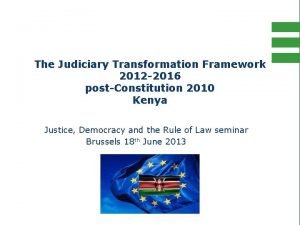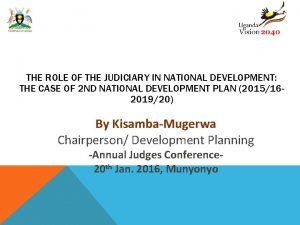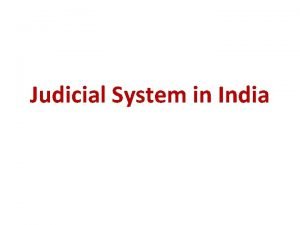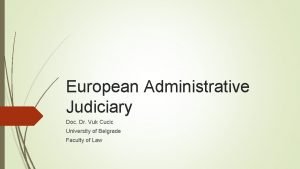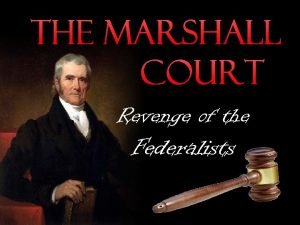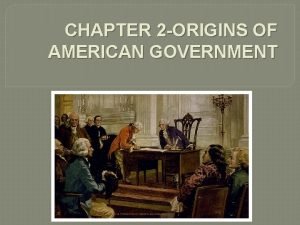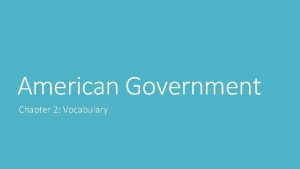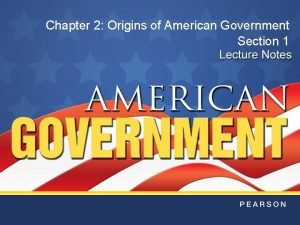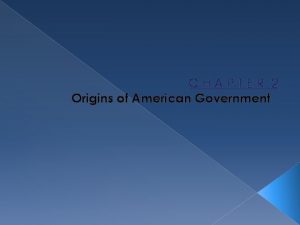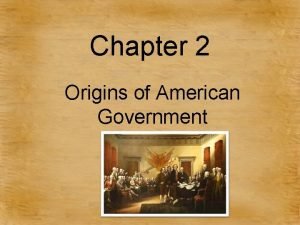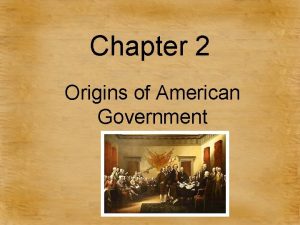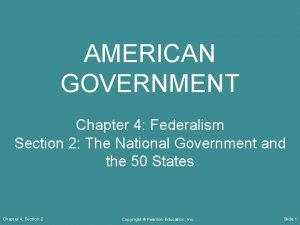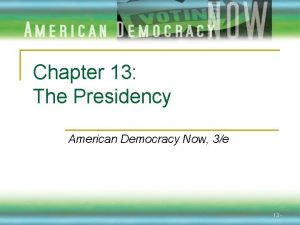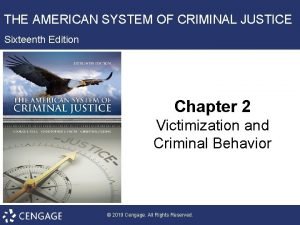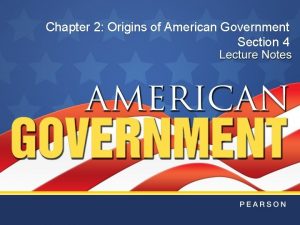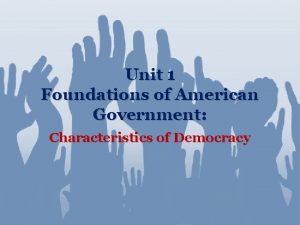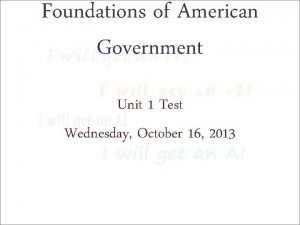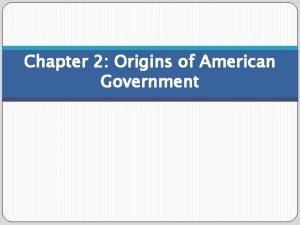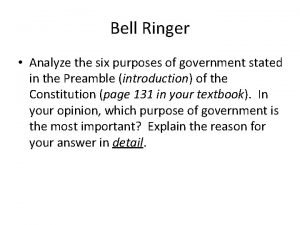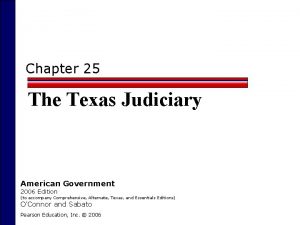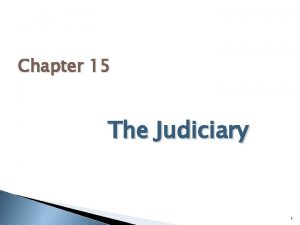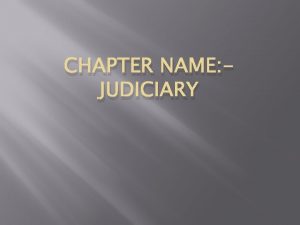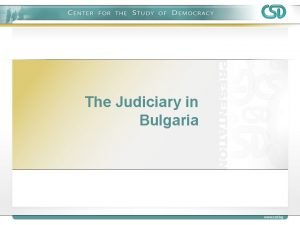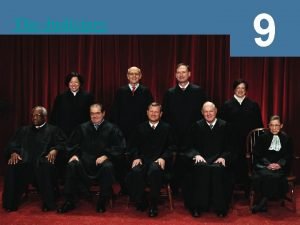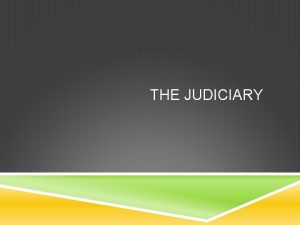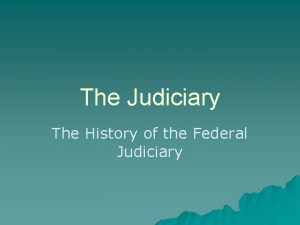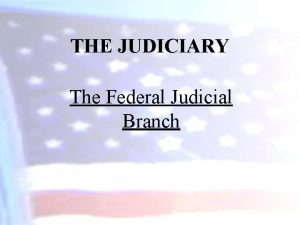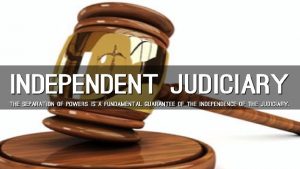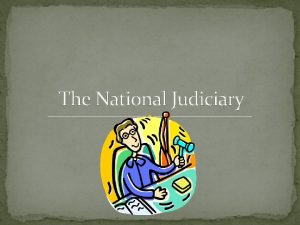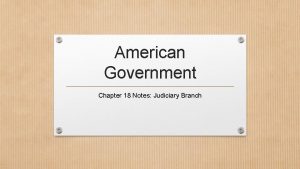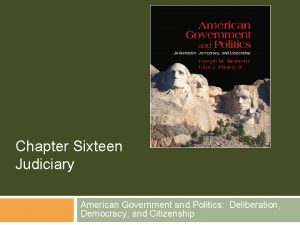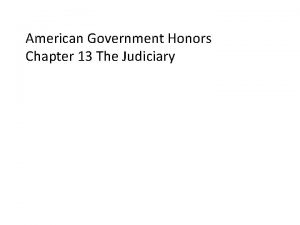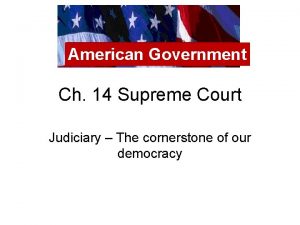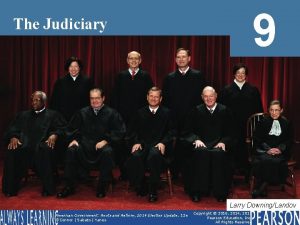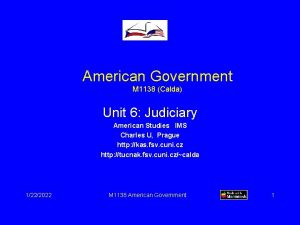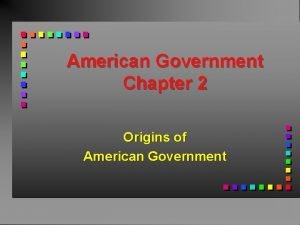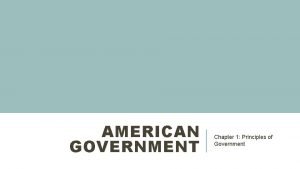Chapter 9 The Judiciary American Government 2006 Edition
































- Slides: 32

Chapter 9 The Judiciary American Government 2006 Edition (to accompany the Essentials Edition) O’Connor and Sabato Pearson Education, Inc. © 2006

The Constitution and the Creation of the Federal Judiciary o Framers devoted little time to the creation of the judiciary. n Believed it posed little of the threat of tyranny they feared from the other two branches. n Anti-federalists did see the judiciary as a threat. o Framers left it to Congress to design the federal judiciary. Pearson Education, Inc. © 2006

The Judicial Power of the United States Supreme Court The following are the types of cases the Supreme Court was given the jurisdiction to hear as initially specified in the Constitution: • All cases arising under the Constitution and laws or treaties of the United States • All cases of admiralty or maritime jurisdiction • Cases in which the United States is a party • Controversies between a state and citizens of another state • Controversies between two or more states • Controversies between citizens of different states • Controversies between citizens of the same states claiming lands under grants in different states • Controversies between a state, or the citizens thereof, and foreign states or citizens thereof • All cases affecting ambassadors or other public ministers Pearson Education, Inc. © 2006

Article III o Did not settle the question of judicial review n Not explicitly stated in the Constitution n Allows the judiciary to review the constitutionality of acts of the other branches of government and the states o Judicial review settled with Marbury v. Madison (1803) for national government’s acts and Martin v. Hunter’s Lessee (1816) regarding state law Pearson Education, Inc. © 2006

Article III o Section I gave Congress the authority to establish other courts as it saw fit. o Section II specifies the judicial power of the Supreme Court and discusses the Court’s original and appellate jurisdiction. n Also specifies that all federal crimes, except those involving impeachment, shall be tried by jury in the state in which the crime was committed. o Section III defines treason, and mandates that at least two witnesses appear in such cases. Pearson Education, Inc. © 2006

Article III o Framers gave federal judges tenure for life “with good behavior. ” n Did not want judges to be subject to the whims of politics, n o the public, or politicians Hamilton argued in Federalist 78 that the “independence of judges” was needed “to guard the Constitution and the rights of individuals. ” Some checks on judiciary included: n Congress has the authority to alter the Court’s jurisdiction. n Congress can propose constitutional amendments that, if n n ratified, can effectively reverse judicial decisions. Congress can impeach and remove federal judges. President (with advise and consent of Senate) appoints federal judges. Pearson Education, Inc. © 2006

The Judiciary Act of 1789 and the Creation of the Federal Judicial System o Established the basic three-tiered structure of the federal court system n District courts: at least one in each state, each staffed by a federal judge. n Circuit Court: avenue for appeal. o Each circuit court initially composed of one district court judge and two itinerant Supreme Court Justices who met as a circuit court twice a year n Supreme Court size set in the Act – chief justice and five associates o Number of justices set to 9 in 1869. Pearson Education, Inc. © 2006

Pearson Education, Inc. © 2006

The Early Court o First session of the Supreme Court initially had to be adjourned when a quorum of the justices failed to show up. o Later, the court decided only one major case. o Relatively lowly status n One associate judge left to become chief justice of a state supreme court. Pearson Education, Inc. © 2006

The Early Court o First decade, Court not co-equal but it did assert itself. n Declined to give President Washington advice on the legality of some of his actions o Attempted to establish the Court as an independent, nonpolitical branch n Tried to advance principles of nationalism and to maintain the national government’s supremacy over the states n Began to pave the way for announcement of the doctrine of judicial review Pearson Education, Inc. © 2006

The Marshall Court: Marbury v. Madison (1803) and Judicial Review o Marbury v. Madison n Supreme Court first asserted the power of judicial review in finding that the congressional statute extending the Court’s original jurisdiction was unconstitutional. n Marshall claimed this sweeping authority for the Court by asserting that the right of judicial review was a power that could be implied from the Constitution’s supremacy clause. n The immediate effect was to deny power to the Court. The long term effect was to establish the power of judicial review. Pearson Education, Inc. © 2006

The American Legal System o Trial courts n Courts of original jurisdiction where a case begins o Appellate courts n Courts that generally review only findings of law made by lower courts o Jurisdiction n Authority vested in a particular court to hear and decide the issues in any particular case n Original jurisdiction: The jurisdiction of courts that hears a case first, usually in a trial. Courts determine the facts of a case under their original jurisdiction. n Appellate jurisdiction: The power vested in an appellate court to review and/or revise the decision of a lower court. Pearson Education, Inc. © 2006

The American Legal System o Criminal law n Codes of behavior related to the protection of property and individual safety o Civil law n Codes of behavior related to business and contractual relationships between groups and individuals Pearson Education, Inc. © 2006

The Federal Court System o Constitutional courts n Federal courts specifically created by the U. S. Constitution or Congress pursuant to its authority in Article III o Legislative courts n Courts established by Congress for specialized purposes, such as the Court of Military Appeals Pearson Education, Inc. © 2006

The Federal Court System o District Courts n 94 federal district courts staffed by 646 active judges, assisted by more than 300 retired judges n No district courts cross state lines. n Every state has at least one federal district court. n The most populous states have four (CA, TX, and NY). Pearson Education, Inc. © 2006

Original Jurisdiction of Federal District Courts o Involve the federal government as a party o Present a federal question based on a claim under the U. S. Constitution, a treaty with another nation, or a federal statute o Involve civil suits in which citizens are from different states, and the amount of money at issue is more than $75, 000 Pearson Education, Inc. © 2006

District Courts o Each federal judicial district has a U. S. attorney. n This individual is nominated by the president and confirmed by the senate. n The attorney is that district’s chief law enforcement officer. n They have a considerable amount of discretion as to whether they pursue criminal or civil investigations or file charges against individuals or corporations. Pearson Education, Inc. © 2006

The Courts of Appeals o o o The losing party in a case heard and decided in a federal district court can appeal the decision to the appropriate court of appeals. 11 numbered circuit courts Twelfth, D. C. Court of Appeals n o Thirteenth, U. S. Court of Appeals for the Federal Circuit n o o o Handles most appeals involving federal regulatory commissions and agencies Deals with patents and contract and financial claims against the federal government Have no original jurisdiction Try to correct errors of law and procedure that have occurred in the lower courts or administrative agencies Hear no new testimony. Pearson Education, Inc. © 2006

The Supreme Court o Decisions of the court of appeals are binding on only the district courts within the geographic confines of the circuit. o Decisions of the Supreme Court are binding throughout the nation and establish national precedents. n Reliance on past decisions or precedents to formulate decisions in new cases is called “stare decisis. ” n Allows for continuity and predictability Pearson Education, Inc. © 2006

How Federal Court Judges Are Selected o Often a very political process o Judges nominated by president and confirmed by Senate o Can reflect the ideological stamp of the president o Senatorial Courtesy n A process by which presidents, when selecting district court judges, defer to the senator in whose state the vacancy occurs. Pearson Education, Inc. © 2006

Who Are Federal Judges? o Typically they have held other political offices. n State court judge or prosecutor n Most have been involved in politics n White males tend to dominate Pearson Education, Inc. © 2006

Appointments to the U. S. Supreme Court o Nomination Criteria n Competence n Ideology or Policy Preference o Strict constructionist: an approach to constitutional interpretation that emphasizes the Framer’s original intentions. n Pursuit of Political Support from Various Groups Pearson Education, Inc. © 2006

The Supreme Court, 2004 Pearson Education, Inc. © 2006

The Supreme Court Confirmation Process o o Investigation Lobbying by Interest Groups Senate Committee Hearings Senate Vote Pearson Education, Inc. © 2006

The Supreme Court Today: Deciding to Hear a Case o 9, 000 cases were filed at the Supreme Court in its 2003 -2004 term. n Not always the norm n 1940 s fewer than 1000 cases filed annually n During the 2003 -2004 term, 90 cases were argued and 73 signed petitions were issued. n Modern period, many of the cases have involved Bill of Rights issues Pearson Education, Inc. © 2006

Supreme Court Today o o Court has two types of jurisdiction n n Original Appellate n Court controls its caseload through the certiorari process. o All petitions for certiorari must meet two criteria: Rule of Four n n n The case must come either from a U. S. court of appeals, a special three-judge district court, or a state court of last resort. Case must involve a federal question. This means that the case must present questions of interpretation of federal constitutional law or involve a federal statute, action or treaty. Cert pool Discuss list Cert granted when at least four justices vote to hear a case Pearson Education, Inc. © 2006

Supreme Court Cases How a Case Goes to the Supreme Court and What Happens After a Case is Accepted Pearson Education, Inc. © 2006

How Does a Case Survive the Process? o Characteristics of the cases the Court accepts: n The federal government is the party asking for review. o Solicitor General n The case involves conflict among circuit courts. n The case presents a civil rights or civil liberties question. n The case involves ideological and/or policy preferences of the justices. n The case has significant social or political interest, as evidenced by the presence of interest group amicus curiae briefs. Pearson Education, Inc. © 2006

Hearing and Deciding a Case o Oral arguments o The conference and the vote o The opinion Pearson Education, Inc. © 2006

Judicial Philosophy and Decision Making o Judicial restraint: n A philosophy of judicial decision making that argues courts should allow the decisions of other branches of government to stand, even when they offend a judge’s own sense of principles. o Judicial activism: n A philosophy of judicial decision making that argues judges should use their power broadly to further justice, especially in the areas of equality and personal liberty. Pearson Education, Inc. © 2006

Models of Judicial Decision Making o Behavior characteristics n Social background o Attitudinal model o Strategic Model o Public opinion Pearson Education, Inc. © 2006

Judicial Policy Making and Implementation o Policy making: n More than one hundred federal laws have been declared unconstitutional. n Ability to overrule itself o Judicial Implementation: n Refers to how and whether judicial decisions are translated into actual public policies affecting more than the immediate parties to a lawsuit. Pearson Education, Inc. © 2006
 Judicial transformation framework
Judicial transformation framework Judicial activism vs judicial restraint
Judicial activism vs judicial restraint Safe public and fair judiciary
Safe public and fair judiciary Department of judiciary
Department of judiciary Judicial hierarchy in india
Judicial hierarchy in india Vuk cucic
Vuk cucic Whats the judiciary act
Whats the judiciary act Chapter 2 american government
Chapter 2 american government Chapter 2 origins of american government vocabulary
Chapter 2 origins of american government vocabulary Chapter 2 origins of american government answer key
Chapter 2 origins of american government answer key Chapter 2: origins of american government worksheet answers
Chapter 2: origins of american government worksheet answers Chapter 2 lesson 1 government in colonial america answers
Chapter 2 lesson 1 government in colonial america answers Chapter 2 origins of american government
Chapter 2 origins of american government American government chapter 4
American government chapter 4 Using mis 10th edition
Using mis 10th edition Using mis (10th edition) 10th edition
Using mis (10th edition) 10th edition What are the three levels of government
What are the three levels of government American democracy now 5th edition
American democracy now 5th edition The american system of criminal justice 16th edition
The american system of criminal justice 16th edition Criminal justice in america 8th edition
Criminal justice in america 8th edition Origins of american government section 4
Origins of american government section 4 Us government unit 1 study guide
Us government unit 1 study guide Unit 1 foundations of american government
Unit 1 foundations of american government Origins of american government section 1
Origins of american government section 1 Foundations of american government unit test
Foundations of american government unit test Origins of american government section 1
Origins of american government section 1 Six purposes of government
Six purposes of government Hát kết hợp bộ gõ cơ thể
Hát kết hợp bộ gõ cơ thể Ng-html
Ng-html Bổ thể
Bổ thể Tỉ lệ cơ thể trẻ em
Tỉ lệ cơ thể trẻ em Chó sói
Chó sói Glasgow thang điểm
Glasgow thang điểm
